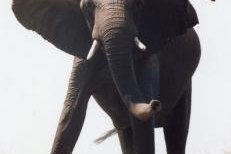Botswana
Chobe Linyanti System
Site Info
Official Information
- Full Name
- Chobe Linyanti System (ID: 5556)
- Country
- Botswana
- Status
-
On tentative list 2010
Site history
History of Chobe Linyanti System
- 2010: Added to Tentative List
- Added to tentative list
- Type
- Natural
- Criteria
Links
- UNESCO
- whc.unesco.org
All Links
UNESCO.org
- whc.unesco.org — whc.unesco.org
Community Information
- Community Category
- Wildlife habitat: Fauna
- Natural landscape: Rivers, Wetlands and Lakes
Travel Information
Recent Connections
News
No news.
Community Reviews
Show full reviews
The TWHS registered as Chobe Linyanti System comprises the Chobe National Park and adjacent private wildlife reserves such as Selinda and Linyanti. Chobe NP itself actually already consists of 4 different zones, of which I visited Savuti and Chobe Riverfront (aka Serondela). Both were on the itinerary of my 6 night mobile camping safari, so I stayed in private camp areas inside the parks.
Chobe NP ranked 13th in the latest poll of best African safari parks and destinations: before Kruger and Etosha, but behind Serengeti, Mana Pools and South Luangwa (and its Botswana neighbours Okavango and Moremi). It is characterized as “Boat and classic safari, Big 5 present (rhino very rare), abundant elephants”.
Our first 2 nights were spent in Savuti. Savuti is named after the Savuti Marsh, a former large inland lake whose water supply is fed erratically by the Savuti Channel. It last overflowed in 2012 and in one of the artificial waterholes around the park you can see a breathing reminder of that: one hippo could not get away in time before it all dried up again, and he now spends his time alone in a little pool. A sad story, but he looks healthy.
From the 3 locations the mobile safari covered (Moremi, Savuti and Chobe Riverfront) this was the one with the most scarce wildlife. Or we were just unlucky. Our guide/driver kept on persisting, following leopard tracks (a mother and a young!) in the early morning around the so aptly …
Keep reading 0 comments
In August 2001, I went on safari in the Okavango Delta (where I stayed at Chitabe Camp), the Savute Channel in northern Botswana (where I stayed at Savuti Camp), and Chobe National Park (where I stayed at Chobe Game Lodge). I have been on safari in most of Africa's principal national parks and I would rank the Okavango/Chobe ecosystem among the top three for wildlife viewing, just behind the Serengeti/Masa Mara (spanning Tanzania and Kenya) and just ahead of Namibia's Etosha National Park.
Keep reading 0 comments
